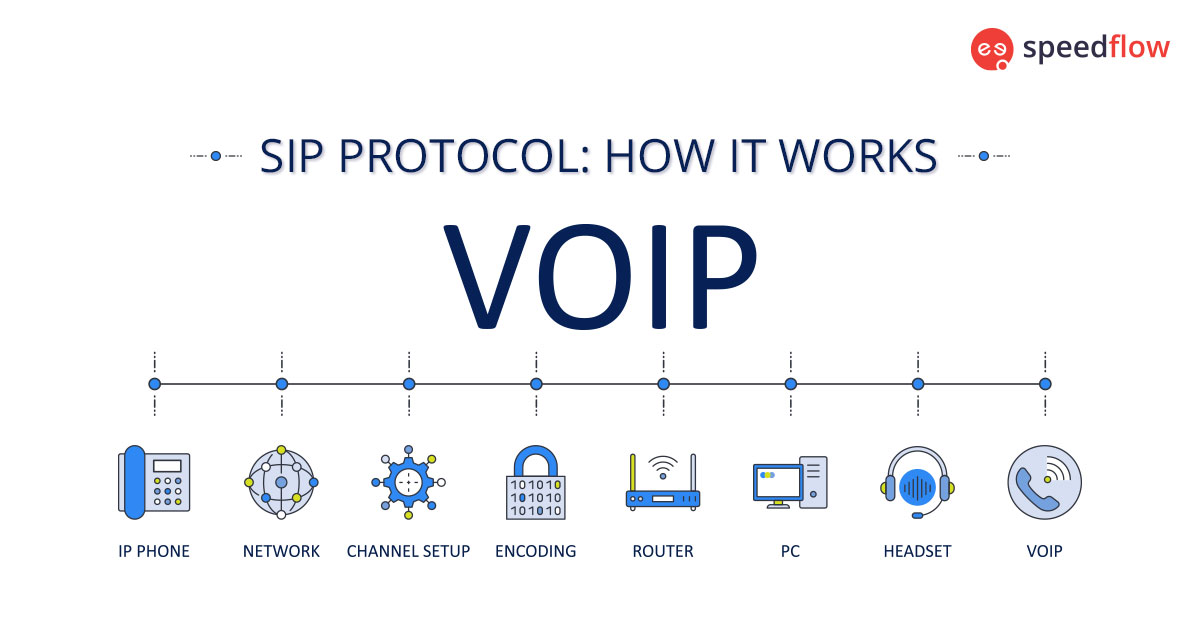The Session Initiation Protocol, commonly known as SIP, is a fundamental protocol that is responsible for initiating, maintaining and terminating multimedia sessions over the Internet. Used predominantly in voice over IP (VoIP) telephony systems, SIP is an essential component in modern communication platforms. This article provides a comprehensive overview of SIP, diving into its history, architecture, and functions.
A Short Overview and History of SIP
SIP is a communication protocol that is used to set up, change, and end sessions. It is an application layer protocol that uses parts of both HTTP and SMTP. As a result, it functions similarly to them, since it operates under the application layer of the Open Systems Interconnection communications paradigm and it can be compared to the client-server model. SIP is designed in such a way, so that it can work with many other protocols that are needed to set up and support communication sessions, such as Real-Time Transport (RTP), Session Description (SDP) and Resource Reservation (RSVP). Additionally, SIP works with both IPv4 and IPv6 and it is a text-based protocol like HTTP. As a result, SIP is simpler to read and debug than H.323 and other comparable signalling protocols. It is used at the session layer, featuring a pretty standard layout.
Mark Handley, Henning Schulzrinne, Eve Schooler and Jonathan Rosenberg came up with the idea for SIP in 1996. Their goal was to facilitate multicast multimedia sessions on the Mbone, which at that time was a network lying on top of the Internet.
In 1999, the protocol was standardized as RFC 2543 and in 2002 the specification was revised in RFC 3261.
How SIP Protocol Works
User Agent Client (UAC)
UAC is one of two client–side components, the other one being the User agent server (UAS), which we will discuss shortly. The UAC is an application that can generate up to 6 requests to the UAS – invite, ack, options, bye, cancel and register. Upon initiating a SIP session, UAC determines essential information for the request, such as protocol, port and IP address of the UAS. This information is dynamic, so pushing in through the firewall might be challenging, that is why it might be a good idea to open the specific application type on the firewall.
User agent server (UAS)
UAS hosts the application responsible for receiving input from UAC and returns back a response. The SIP result codes can be classified as: 1xx (informational), 2xx (success), 3xx (redirection), 4xx (client error), 5xx (server error), and 6xx. It is worth mentioning that the UAS can send more than one response, for example when it receives an invite request from UAC.
Proxy Server
The proxy server works as a middleman or a mediator, which is responsible for servicing and forwarding requests to the appropriate destination. It could be part of intra-organizational configurations, where it handles all SIP traffic in the company. Any time a message is sent, it passes through the proxy servers and then it is sent to the receiving SIP client. Consequently, those intra-organizational set ups could be linked to inter-organizational ones. In this case the proxy servers of different companies communicate with each other for sending and receiving messages.
Redirect Server
A redirect server will alert a client if the destination the caller is attempting to reach has changed, very similar to a web page with an integrated redirect tag. The client will rerequest the call after receiving the updated data from the redirect server and using the new destination information.This lessens the workload on proxy servers and increases the reliability of call routing. By doing this, a call can be swiftly forwarded from a proxy without the latter having to finish the connection itself.
Registrar Server
Users can provide the addresses at which they can be reached to a proxy or a redirect server. The SIP client sends a REGISTER request when a user wants to change their address. The SIP client’s REGISTER requests are accepted by a registrar server, which also logs the user’s updated data. This data is typically used by the SIP server to populate the location service, so that it can direct incoming requests to the appropriate address.
Future Prospects of SIP
As digital transformation continues to redefine the landscape of communication, SIP’s significance will evolve and adapt to these changes. Here’s what the future may hold for SIP:
Integration with AI and Machine Learning
As businesses increasingly adopt AI-driven solutions, SIP can potentially be integrated with AI models to enhance call routing, improve voice quality, detect anomalies, and even predict potential failures in the network.
Enhanced Mobile Integration
The proliferation of mobile devices necessitates more robust solutions for SIP mobile communications. This might lead to improvements in battery-efficient SIP clients, better hand off mechanisms between cellular and VoIP networks, and augmented reality (AR) integration for richer multimedia experiences.
IoT and SIP
The Internet of Things (IoT) is another frontier where SIP can shine. Imagine smart devices initiating SIP sessions to communicate, share status, or even alert users. This integration could lead to smarter homes, cities, and industries.
Enhanced Security Features
Given the rising cyber threats, it’s anticipated that SIP will undergo further security enhancements. This might include more robust encryption standards, better user authentication mechanisms, and integration with blockchain technology for secure, tamper-proof logs.
WebRTC and SIP Collaboration
WebRTC (Web Real-Time Communication) is an open-source project that enables web browsers and mobile apps to communicate in real-time via simple APIs. The convergence of SIP and WebRTC can make browser-based real-time communications more streamlined, eliminating the need for external plug-ins or software.
Conclusion
The Session Initiation Protocol, while being more than two decades old still remains a cornerstone in the world of IP-based communications. Its adaptability, coupled with the rapid pace of technological advancement, ensures its relevance in the foreseeable future. Businesses and tech enthusiasts alike would do well to keep an eye on SIP’s evolution, as it will likely play a pivotal role in the next wave of communication innovations.
Our proprietary Class 4 Softswitch platform MediaCore supports SIP and it helps VoIP providers with automating tasks and increasing productivity. To learn more about it or to schedule a demo, you can send us an email to info@speedflow.com.




